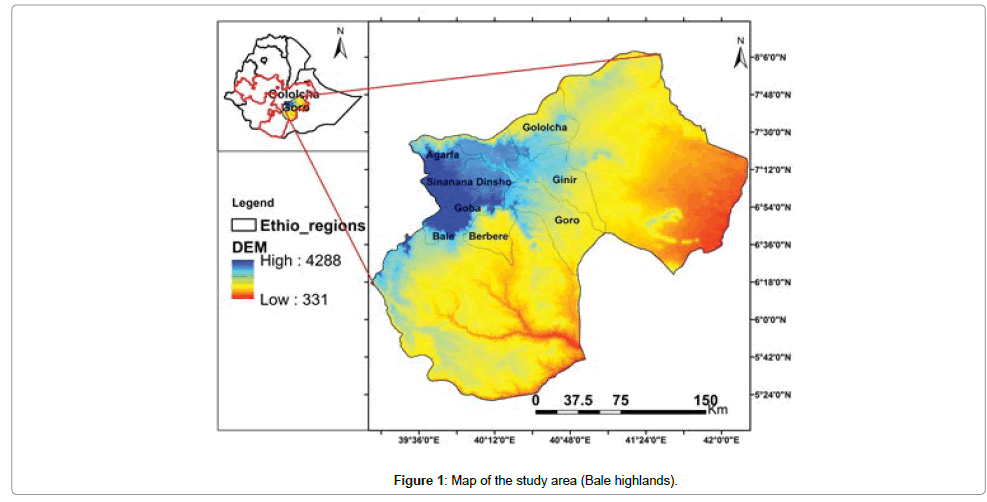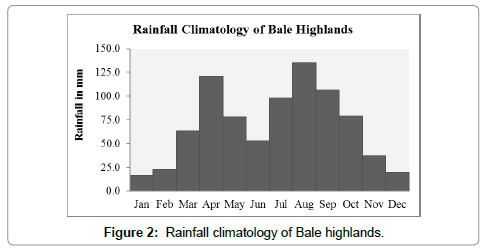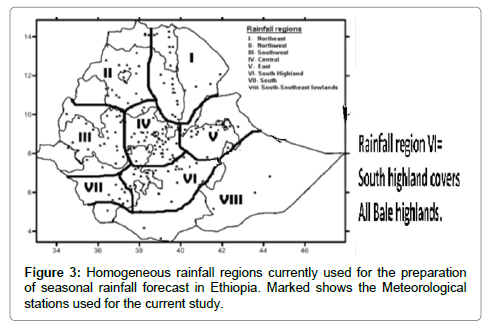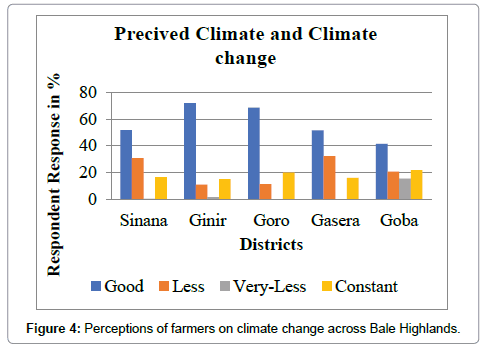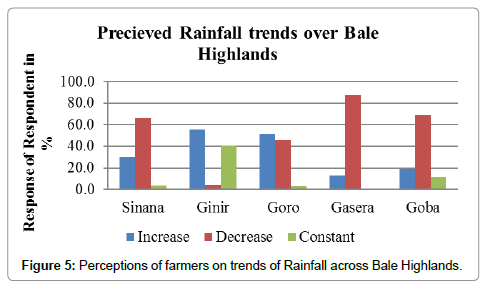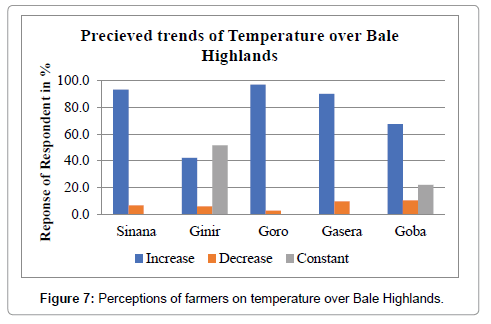Perception of Farmers on Climate Change and their Adaptive Strategies over Bale Highlands, Southeastern Ethiopia
Received: 16-Aug-2018 / Accepted Date: 10-Sep-2018 / Published Date: 15-Sep-2018 DOI: 10.4172/2157-7617.1000491
Keywords: Perception of farmers; Climate change; Adaptive strategies; Bale highlands
Introduction
Recent climate change impact assessment studies have indicated that changes in rainfall (amount and variability) and increase in temperature are causing stresses on agriculture, water as well as human health, and likely to continue to progress negatively in the future [1]. Consequences of climate change and other environmental factors on the agricultural sector have to be dealt with proper adaptation mechanisms to building resilience and reducing vulnerability. In the agricultural sector, the frequently implemented adaptation methods are the use of new crop varieties and livestock species that are better suited to drier conditions, irrigation, crop diversification, adoption of mixed crops and livestock farming systems, and changing planting dates [2].
The recent Intergovernmental Panel on Climate Change (IPCC) 5th Assessment Report [3] indicated that the least developing countries, especially Africa, and the low-lying coastal areas islands nations are the most vulnerable to climate change. The climates of eastern Africa are complex and highly variable. Providing realistic climate risk management strategies for reducing climate variability risks as well as adapting to climate change will therefore require good knowledge of the past and present climates [4].
Adaptation to climate change is the process through which people reduce the adverse effects of climate on their health and well-being and take advantage of the opportunities that their climatic environment provides vulnerability and adaptive response in the context of climate and climate change [5] quoted in an anatomy of adaptation to climate change and variability [6]. According to the IPCC Third Assessment Report, adaptation “has the potential to reduce adverse impacts of climate change and to enhance beneficial impacts but will incur costs and will not prevent all damages.” Furthermore, it is argued that human and natural systems will, to some extent, adapt autonomously and that planned adaptation can supplement autonomous adaptation. However, “options and incentives are greater for adaptation of human systems than for adaptation to protect natural systems [1]. According to IPCC [7] the definition of adaptation to climate change, that generically speaks of the adjustment in natural and human systems in response to actual and expected climatic stimuli, such as to moderate harm or exploit beneficial opportunities.
Many studies have documented that there is increasing trends for mean monthly minimum and maximum temperature over many parts of Ethiopia [8,9]. The evidences of climate change signal at local scales in Ethiopia were documented by Mengistu and Bayable [10]. As a result of climate change rainfall has shown increasing trends in the southeastern highlands of Ethiopia. Though considerable research reports are there in and around Ethiopia, there is no wide coverage of Bale Highlands due to the fact that this region is least represented by representative meteorological stations during the past study? So, the current study was undertaken to examine the link of farmer’s perception on climate change with observed meteorological parameter over Bale Highlands.
Community based local information on climate change signal and its burden on socio-economic sectors would collect from informants and elders. The results generated from this study will be expected to demonstrate how the farmer’s perception on climate change links with the meteorological observation over Bale Highlands. Smallholder farmers, whose livelihood depends on crops and livestock, mechanized private or state farms, agricultural researchers and decision makers would be the major beneficial from the current study.
Data and Methodology
Background of the study area
Highlands of Bale is located between 6.45° N to 7.45° N and 39.47° E to 40.77° E in the southern parts of Oromia National Regional State of Ethiopia. The elevation of the area ranges from 1500 to 3500 meter above sea level [11]. The study area covers 13,291 km2 and is bordered in the south by Mena, in the west by West Arsi Zone, in the north by Arsi Zone, in the northeast by Legehida district, in the southeast by Guradamole district of Bale zone and in the east by Sewena district. The highest point in Bale Highland is Mount Tuludimtu (4377 m and Batu Mount (4307 m). Based on the topography Bale is divided into Dega (Highland), Waine Dega (mid lands), and Kola (low lands). Most of these districts are characterized by bimodal rainfall types. The average rainfall is about 590 mm in the Ganna and 560 mm in Bona season. Barley and Wheat is the main crop produced in the selected area [12]. Various studies indicate that the study area is dense or populous because the region is highly fertile and suitable for agricultural activities [13]. This study is mainly focused on the Highlands (Figure 1) parts of Bale Zone [14].
Characteristics of rainfall and its distribution over bale highland
The characteristics of rainfall climatology over Bale highland is cover 30 years rainfall data from 1986 to 2015. Rainfall in the selected study area is bimodal types which have two rainy periods and one dry period (Figure 2). The two rainy periods are locally known as Kiremt (June to September) and Belg (February to May), which are long and short rainy periods, respectively [15,16]. Those region experiences two rainy seasons, where the long rainy season occurs between July and October, with the highest peak in August and the small rains occurs between March and June with the highest peak is in April. 600-1000 mm of rain falls annually in the lower altitude areas and 1000-1400 mm in the higher altitudes [17,18]. Mean annual rainfall distribution increases from east and southeast to west, north and southwest of the highlands. Overall, the mean annual rainfall totals range from 844.6 to 1321.7 mm over the eastern and western parts of the highlands, respectively.
Data Sources
All historical meteorological data were collected from National Meteorological Agency (NMA) of Ethiopia Bale Robe Meteorological Branch Directorate. These datasets include rainfall and average temperature. For the current study, 5 stations of meteorological data were used. The primary data were collected from 5 districts of Bale Highlands (Figures 3-5).
Sampling and sample size determination
Simple random sampling (SRS) technique was used to select the study population for sample collection in the study area. Districts are located in the same rainfall homogeneity as depicted in Figure 6 of NMA‘s eight homogeneous rainfall regions [19]. For this study rainfall region VI= South highland covers all Bale highlands.
SRS technique is applied on household farmers or kebeles in each selected district. In order to determine the desired sample size there is no previous reports of population in the Bale Highland was considered as expected prevalence. The expected prevalence rate was 50% for the area within 95% confidence intervals (CI) at 5% desired accuracy as stated by Thrusfield [20]. To develop the perception among local community about the adaptation and mitigation strategies of climate change impacts, data was collated using structured questioners and for sample size:
 (1)
(1)
Where, n is Sample size determination and allocation proportion.
Z is Confidence of level 95% (Z = 1.96)
P is Proportion (p = 0.5)
q=1-p
d is Design effect and use to composet the error or reduce the error (d= 1.5, 2 and 3 but for this study d=2)
e is Margin of error (e = 0.5)
A total of 768 respondents were randomly selected across five districts of Bale Highlands and interviewed in August to October 2015. Data were collected on perception of the farmers on climate and climate change, Characteristics of weather pattern, onset and cessation of short and main rainy seasons and adaptation system. Farmers were also requested on a set of question link with their perception on past and present observed trend of rainfall and temperature and measures they take to adapt to the changes. The survey results were entered in to Microsoft Excel 2010. Responses of farmers to rainfall change in the last twenty years ago were categorized under “Changing in timing of Rainfall pattern, Temperature, Sun heat. The answers for the selected parameters are categorized as ‘Increase, Decrease and Constant. For frequency of drought, frequency of hungry, Crop disease, Animal disease and human disease, the answers categorized to “increase, decrease, constant and unsure. Most respondents responded that they received weather and climate information through TV, Radio, Seminar and otherwise no enough information. Likewise, farmers were requested a set of questions on the period that they have get the weather and climate information, Onsets and Cessations of seasons, Mechanisms of adaptation activities. Questions were distributed for house hold farmer from 5 districts in Bale Highlands. Namely: Sinana, Ginir, Goba, Gasera and Goro for 7, 10, 5, 7, and 7 Kebeles, respectively (Table 1).
| No. | Districts Name | No Kebeles | No of Respondent for each Kebeles | Total No of respondent in Districts |
|---|---|---|---|---|
| 1 | Sinana | 7 | 30 for each Kebeles | 210 |
| 2 | Ginir | 10 | 21 for 3 & 22 for 7 Kebeles | 217 |
| 3 | Goba | 5 | 15 for 3 and 16 for 2 Kebeles | 77 |
| 4 | Gasera | 7 | 17 for 2 and 18 for 5 | 124 |
| 5 | Goro | 7 | 20 for each Kebeles | 140 |
| Total | 36 | 768 | ||
Table 1: Number of farmers responded to the questionnaire.
The selected participants at the household level were selected randomly and were contacted with a formal letter written from Madda Walabu University and asked for interview permission. The interviewed data were collected from August to October 2015 by 15 data collectors.
Result and Discussion
Farmer perception’s on the idea of climate and climate change
Farmers perceive differently on the concept of climate change and its impact on their livelihood. The level of their understanding depends on their exposure, education and location. In this study it was found that farmers have responded as less on the perception in Goba district, they possess on climatic issues. That means they had either no information or according to their perception no climate change signal in their localities (Figure 4).
Perception of farmers on rainfall trends
Farmers observe in a different way on the concept of rainfall trends for the last 20 years. Figure 5 showed that 62.5%, 4.1%, 45.7%, 87.1% and 66.8% of the farmers in Sinana, Ginir, Goro, Gasera and Goba districts were perceived a decreased trend of annual rainfall, respectively. Likewise, about 30%, 55.3%, 51.4%, 12.9% and 19.5% of the farmers in the same districts noticed an increase in annual rainfall, respectively. Most farmers reported that lack of rain is one of the main constraints in agricultural productivity and many also indicated that rainfall is becoming more erratic.
However, the perception of farmers’ that indicate decreased trend of rainfall did agree with observed meteorological data of the area under study. In all stations except Ginir the observed meteorological rainfall data shown as negative trends and Ginir station show as positive trends that did agree with the farmer’s perception (Figure 6).
Farmer’s perception on the temperature
Figure 7 shows that 85.26% of farmers interviewed perceived a change in temperature either increased or decreased. According to the survey data in Sinana, Goro and Gasera districts almost more than 90% were perceived an increase in temperature and less than 10% were perceived a decrease in temperature. In Ginir and Goba districts 42.4% and 67.5% were perceived as increase in temperature as well as 6% and 10.4% perceived a decrease in temperature, respectively. 51.6% and 22.1% of farmer’s perception in Ginir and Goba districts were perceived as constant.
To verify farmers perceived change in temperature, the historical mean annual temperature data from five meteorological stations, Sinana, Goba, Ginir, Goro and Gasera districts, respectively were used. The observed temperature in five meteorological stations and the farmer’s perception reflection showed that an increased trend of temperature.
Figure 8 shows as an increased trend of temperature for the last 20 years over Bale highlands which agree with the community perception of the selected districts. Farmers perceive that indicate increased trend of annual temperature did agree with observed meteorological data of the area, which shows significant trend in all stations of the selected districts.
Adaptation strategies by farmers in the face of increasing temperature
In spite of the perceived increase in temperature by the majority of farmers, only 93.5% indicated the adoption of some adaptation measures (Figure 9). Tree planting, Water Conservations, Flood Protection and Protecting Tree cutting were identified as the major adaptation strategies to a change climate. In all districts the highest percent of adaptation mechanism were all more than 26% in each district. Generally, 93.5% Farmers have one of adaptation methods seemed to have changed their management in response to declining of rainfall, increased of temperature as well as sun’s heat but only 6.5% of farmers were no have adaptation measurement. That means they had either no information or according to their perception no criticized by climate change signal in their localities.
Conclusion
In conclusion, this study has revealed that there are significant climate change and an increase of annual temperature as well as a decrease of rainfall in Bale Highlands. Climate change is mainly threatening the rain-fed agricultural sector by affecting the livelihood of the rural communities, particularly in highly vulnerable and poorest countries in Africa and Ethiopia is one of typical example. This study is based on primary data produced from the local farmers. In order to evaluate their perception, use meteorological parameters like rainfall and temperature data from different meteorological station in Bale highlands. Trends of rainfall shown as a decrease in the study area and the trends of temperature was increase in the study area. Climate change is mainly threatening the rain-fed agricultural sector by affecting the livelihood of the rural communities of Bale Highlands. Trends of rainfall shown as a decrease in the study area and the trends of temperature was increase in the study area. The community had their adaptation mechanism to mitigate climate change impacts. 93.5% of Farmers have one of adaptation methods seemed to have changed their management in response to declining of rainfall, increased of temperature as well as sun’s heat but only 6.5% of farmers were no have adaptation measurement. That means they had either no information or according to their perception no criticized by climate change signal in their localities.
Recommendations
The concerned organization will make awareness about climate change issue for those had no information of climate change signals over study area. Researchers conduct water requirement satisfaction trend and link with climate changes in the study area which is significant for local farmers. Investigate the specific local onset, cessation and length of growing period link with climate changes. Scholar the climate change adaptation and mitigation strategies for local community.
References
- IPCC (2001) Climate Change: Impacts, adaptations and vulnerability. Cambridge University Press, Cambridge, UK.
- Kurukulasuriya M (2008) A Ricardian analysis of the impact of climate change on African cropland. African Journal of Agricultural and Resource Economics 2: 1-23
- Ogallo L (2008) Climate variability and change. The impacts in Eastern Africa Sub-region. Proceedings of EMIBAMA First Scientific Conference on Climate Change and Variability and its Impact on Ethiopia and Eastern Africa. Addis Ababa Ethiopia 16: 8
- Burton I (1997) Vulnerability and adaptive response in the context of climate and climate change. Climatic Change 36: 185-196.
- Smit B, Burton B, Klein RJT, Wandel J (2000) An anatomy of adaptation to climate change and variability. Climatic Change 45: 223-251.
- IPCC (2007) In: Climate Change 2007: Impacts, adaptation and vulnerability. Contribution of Working Group II to the Fourth Assessment Report of the Intergovernmental Panel on Climate Change Cambridge University Press, Cambridge, UK and New York, USA. 2: 869-883.
- NAPA (2007) The Federal Democratic Republic of Ethiopia, Ministry of Water Resources and National Meteorological Agency, Ababa press, Ethiopia.
- Ogallo L (2009) Climate variability and change in Africa: A review of potential impacts on terrestrial water resources in: Groundwater and Climate in Africa, Proceedings of the Kampala Conference, Uganda, IAHS Publishers 334: 47-51
- Mengistu GT, Bayable E (2011) Evidences of climate change signal at local scales of Ethiopia. proceedings of the Global Conference on Global warming, Portugal.
- FARM Africa, Sahel SOS (2007) Bale Eco-Region Sustainable Management Programme (BERSMP). Annual report press, Africa.
- WBISPP (1995) Woody Biomass Inventory and Strategic Planning Project: Socio-cultural and Economic aspects of crop, livestock and tree production. The Woody Biomass Inventory and Strategic Planning Project. Ethiopian Energy studies and Research Center, Ethiopia.
- Muleta D, Desalegn O, Bikila Z (2015) Using NDVI for prediction of yield for specific crop type: Case Study of Sinana District in Bale Zone, Oromia Region of Ethiopia.
- BZFEDO (2010) Bale Zone Finance and Economic Development Office: Physical and socio-economic profile of Bale zone, Oromia Region of Ethiopia.
- Korecha D, Sorteberg A (2013) Construction of homogeneous rainfall regimes for Ethiopia. International Journal of Climatology 2: 1.
- Miehe S and Miehe G (1994) Ericaceous forests and heath lands in the Bale mountains of South Ethiopia: Ecology and Man’s Impact. Siftung Walderhaltung, Africa.
- Morton B (1976) A field guide to Ethiopian minerals, rock and fossils. Addis Ababa University Press. Addis Ababa, Ethiopia.
- Korecha D, Barnston AG (2007) Predictability of June-September Rainfall in Ethiopia. Monthly Weather Review 135: 628-650
- Thrusfield M (2007) Veterinary epidemiology (3rd edn). Blackwell Science, Oxford, UK. 2: 51-281.
Citation: Legese W, Koricha D, Ture K (2018) Perception of Farmers on Climate Change and their Adaptive Strategies over Bale Highlands, Southeastern Ethiopia. J Earth Sci Clim Change 9: 491. DOI: 10.4172/2157-7617.1000491
Copyright: © 2018 Legese W, et al. This is an open-access article distributed under the terms of the Creative Commons Attribution License, which permits unrestricted use, distribution, and reproduction in any medium, provided the original author and source are credited.
Select your language of interest to view the total content in your interested language
Share This Article
Recommended Journals
Open Access Journals
Article Tools
Article Usage
- Total views: 4812
- [From(publication date): 0-2018 - Dec 08, 2025]
- Breakdown by view type
- HTML page views: 3860
- PDF downloads: 952

